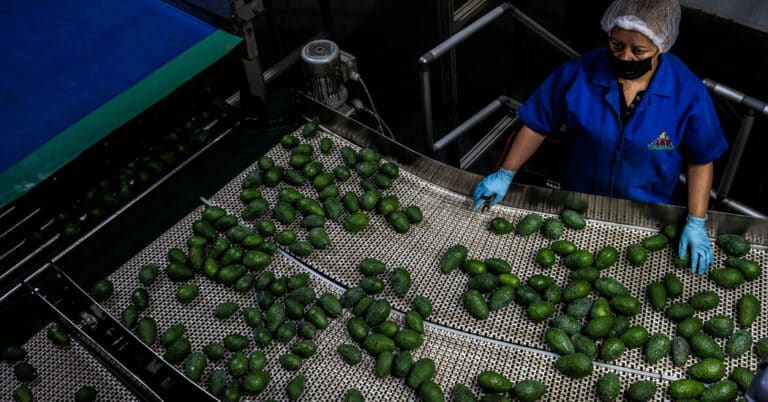Times Insider explains who we are and what we do and delivers behind-the-scenes insights into how our journalism comes together.
In October, the Times journalists Simon Romero and Emiliano Rodríguez Mega were in the Mexican state of Michoacán, traveling across volcanic plateaus that are known for their towering pine and oak forests.
But everywhere they looked, they saw avocado plants. Avocados lined roadways and lakes, ran through backyards and filled areas where protected forests had once stood.
“I had really no idea the levels of deforestation that are taking place,” said Mr. Romero, who, as a Times reporter, has worked in Latin America for parts of two decades.
Mr. Romero and Mr. Mega, based in Mexico City, were in Michoacán to understand how the growing demand for avocados in the United States is transforming lifestyles and landscapes across the region, where more than 25,000 acres of avocado orchards sit on land that as recently as 2014 was covered by forests. Their report, with photographs taken by César Rodríguez, was published in The Times last week.
The journalists traveled by car through Michoacán for fours days. The presence of avocados was evident beyond the orchards: Vendors sold them at food stands, the fruit filled local markets, and pictures of them dominated roadside advertisements.
Speaking with workers in the industry and local residents, the journalists found that people were happy to explain the effects of avocado expansion but afraid to have their names used. The lucrative avocado trade has attracted criminal gangs who threaten environmental activists and others who resist deforestation with kidnapping and death.
Although the journalists had expected some people to be reluctant about being identified — Michoacán is a volatile region where drug cartels hold sway — the level to which people were afraid was remarkable, Mr. Romero said.
“It’s understandable,” he added. “These people have everything to lose: their livelihood, their farmlands, their lives.”
This meant that The Times quoted them anonymously to respect their safety, a measure that extended to photography, too. People in Michoacán didn’t want to be pictured, even from behind or in silhouette. So Mr. Rodríguez had to get creative. In one photo, he photographed someone’s hand as it offered flowers at a shrine to the Virgin Mary. The frame appears blurred, obscuring the person’s identity.
That fear of being named was shared by public officials, several of whom spoke to Mr. Romero and Mr. Mega about various levels of corruption involved in the avocado trade. Mr. Mega recalled meeting one source under cover of night in a supermarket parking lot.
One man, Donaciano Arévalo, 60, was willing to be named. For years, Mr. Arévalo has been embroiled in a legal battle to reclaim a 50-acre parcel of land after he discovered men with chain saws cutting down trees to make way for avocado plants.
“He had deposited a lot of hope into that land that he bought,” said Mr. Romero, explaining that Mr. Arévalo wanted to leave it to his children.
The three journalists had to mind their own safety, too. While reporting, Mr. Romero, Mr. Mega and Mr. Rodríguez didn’t travel at night, were careful about the roads they used and, at one point, decided not to venture deeper into the region after being warned of substantial cartel activity in the area.
It was just as important to report on the mind-set of the local citizens as it was to illustrate the vast and dramatic physical changes to the countryside, where avocado producers, often with the help of the gangs, burn native forests before clearing them. Mr. Rodríguez took photos from hilltops and used an aerial drone. “Once you’re up there, you can see the contrast of the forest: what is burned, what remains and what is avocados,” he said.
It has been estimated that the area in Michoacán used for avocado crops could increase in size by more than 80 percent by 2050 as demand for the fruit increases in the United States. Americans already eat three times as many avocados as they did two decades ago, and avocado exportation from Michoacán is expected to skyrocket in the coming decades as that appetite grows.
At a packing house in the town of Uruapan, the self-proclaimed “avocado capital of the world,” workers allowed the Times journalists to see how avocados were processed. There, the driving force changing the land was clear.
“The avocados that had imperfections, those were for the local markets,” Mr. Mega said. “And the prettiest avocados went to the U.S.”


